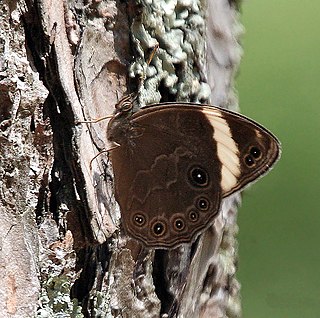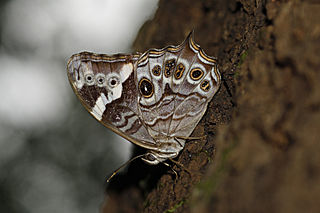In Greek mythology, Lethe, also referred to as Lesmosyne, was one of the rivers of the underworld of Hades. Also known as the Amelēs potamos, the Lethe flowed around the cave of Hypnos and through the Underworld where all those who drank from it experienced complete forgetfulness. Lethe was also the name of the Greek spirit of forgetfulness and oblivion, with whom the river was often identified.

The Juggernauts is a Big Finish Productions audio drama based on the long-running British science fiction television series Doctor Who.

Lethe is a butterfly genus from the subfamily Satyrinae in the family Nymphalidae. The genus was erected by Jacob Hübner in 1819. It includes the treebrowns, woodbrowns, foresters and their relatives. The species in the genus Lethe occur in temperate-tropical southern and eastern Asia, up to Indonesia and in North America.

The Satyrini is one of the tribes of the subfamily Satyrinae. It includes about 2200 species and is therefore the largest tribe in the subfamily which comprises 2500 species.

Lethe rohria, the common treebrown, is a species of satyrine butterfly found in Asia.

Lethe europa, the bamboo treebrown, is a species of Satyrinae butterfly found in Asia.
In Greek mythology, Algea is used by Hesiod in the plural as the personification of pain, both physical and mental. They were the bringers of weeping and tears.

Lethe Vallis is a valley in the Elysium Planitia on Mars, located at 4° North and 206.5° West. It is 225 km long and is named after river Lethe in Katmai National Monument, Alaska, USA. Lethe Vallis originates at the SE margin of the West Elysium Basin. West Elysium Basin probably contained a lake that was 500 km across and received water from Athabasca Vallis. It was probably formed in just days or weeks and had a discharge about like the Mississippi. Some have suggested it was formed from lava flows, but lava would not be able to flow over such a low gradient for so long a distance.

Lethe visrava, the white-edged woodbrown, is a species of satyrine butterfly found in Asia, where it is known from Sikkim to Bhutan, Assam and Burma.

Lethe chandica, the angled red forester, is a species of Satyrinae butterfly found in the Indomalayan realm.

Lethe kansa, the bamboo forester, is a species of Satyrinae butterfly found in the Indomalayan realm

Lethe gulnihal , the dull forester, is a species of Satyrinae butterfly found in the Indomalayan realm

Lethe goalpara , the large goldenfork, is a species of Satyrinae butterfly found in the Indomalayan realm.

Lethe baladeva, the treble silverstripe, is a Satyrinae butterfly found in the Indomalayan realm. The species was first described by Frederic Moore in 1866.

Lethe dura, the scarce lilacfork, is a species of Satyrinae butterfly found in the Indomalayan realm.













